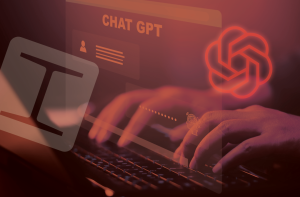The good, the bad, and the ugly isn’t just a famous Western. It’s also the perfect way to describe how ChatGPT has brought changes and opportunities to the world of marketing – forever.
In November of 2022, a company called OpenAI unveiled ChatGPT, its chat interface to connect millions of people to an advanced machine-learning model known as Generative Pretrained Transformer or GPT.
On that unseasonably warm November Wednesday when ChatGPT went public – a day which may prove to be a massive watershed moment in digital marketing – the AI technology that powers ChatGPT was not actually new. Only the interface was new, the powerful chat tool available to the general public — the front door.
What changed was the unprecedented access to vast amounts of information for billions of non-developers worldwide through a simple question-answer chat feature. Up until that point, it was only coders who could tap into GPT’s vast knowledge and human-like sensibilities.
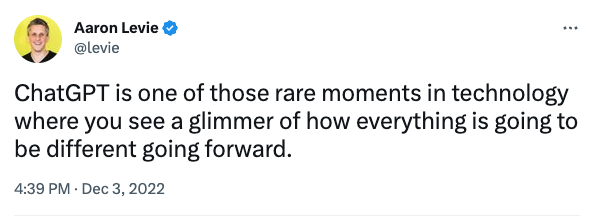
The implications are huge. Let’s look at the good, bad, and ugly of ChatGPT.
A Brief Background on Open AI and ChatGPT
OpenAI, founded in 2015 by Elon Musk, Sam Altman, Greg Brockman, Ilya Sutskever, John Schulman, and Wojciech Zaremba, is one of the most influential AI/tech research companies in the world. Its mission was to develop and promote solid AI tools and to make the advances of AI available to everyone.
OpenAI was a pioneer in the development of GPT. The GPT model was trained on enormous amounts of text data from the internet but does not actually search the internet in real-time. Through its pre-trained library of information that keeps on learning, the model has the ability to generate text that is almost indistinguishable from human writing.
ChatGPT is a robot you can chat with and ask to complete tasks such as writing essays, creating code, and pulling information. It has the ability to interact in conversational dialogue form and provide human-like responses. It uses language models to predict the next word in a series of words. Reinforcement Learning with Human Feedback (RLHF) is an additional layer of training that uses human feedback to help ChatGPT learn the ability to follow directions and generate responses that are satisfactory to humans.
Users can enter a prompt like “What should I pack for a trip to Thailand in August?” and it will give you a helpful list of items to pack without ads or distracting modules or paid sponsorships. Just simple – exactly what you asked.
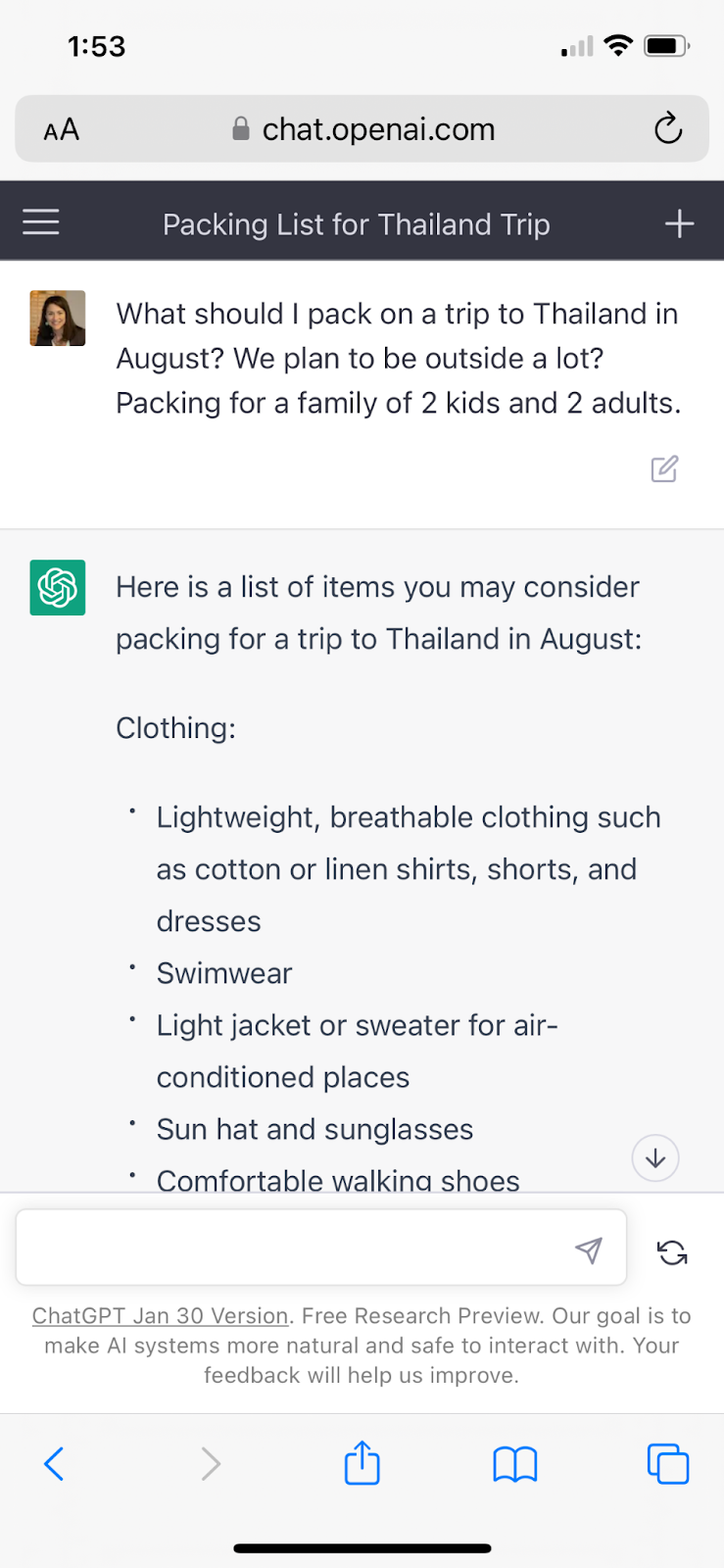

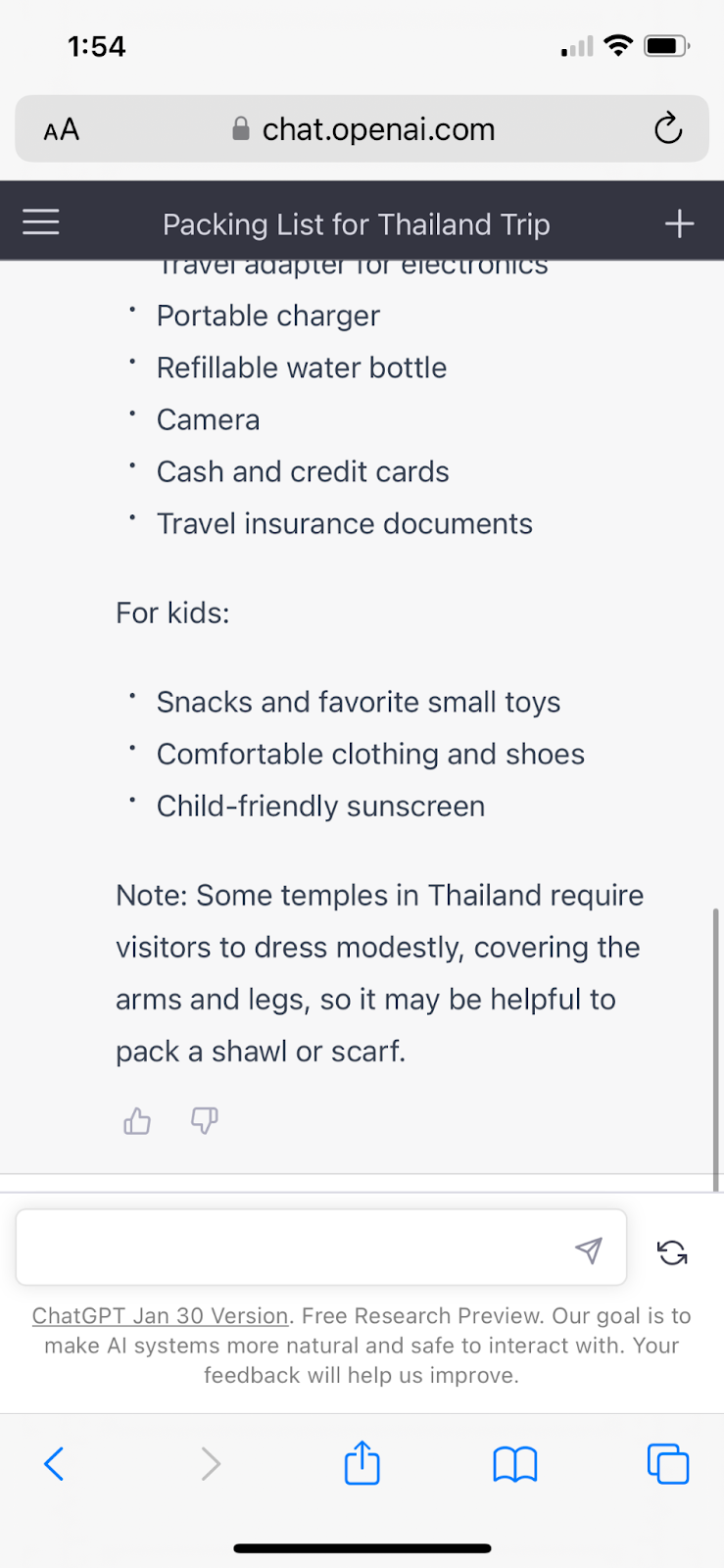
ChatGPT will also remember its first response and can enhance its answer when users provide more, like “what about for kids?”
ChatGPT: The Good
Apart from generating a list of what to pack for a vacation in Thailand, what is ChatGPT really good at? Where does it excel?
Speed:
ChatGPT can produce a lot of text, written very much like a human, in response to a prompt in a matter of seconds. It can save time for humans to research and compose original content, articles, scripts, code, jokes, questions, lists, and even books.
Flexibility & Perpetual Learning:
With ChatGPT, you can also ask it to generate and adapt written pieces in a wide range of styles and tones, enabling it to be used in many different scenarios. Additionally, it can be prompted with specific information or questions to generate more focused and relevant content. For example, you can get ChatGPT to write emails or website content in the style of a specific comedian or playwright. Here’s the opening of a sales email written in the style of Oscar Wilde:

Personalization:
ChatGPT can create customized content based on user feedback on the fly. Users can help ChatGPT tailor certain articles, essays or emails based on ongoing prompts in a conversational manner. It really feels like a conversation with a better-than-mediocre writing robot.
ChatGPT: The Bad
ChatGPT is not perfect. As with anything new to the market, it’s in flux. There are kinks in the system. Before you fire your copywriter, take note of mistakes ChatGPT is making so you can avoid embarrassing or costly blunders.
Unreliable Info and Incomplete Sourcing :
While ChatGPT can generate high-quality text, it is not always accurate or up-to-date. Additionally, the information it provides may not always be reliable or trustworthy, as it has not been verified by a human expert.
Currently, its learning model knows nothing of recent events as its dataset is from November of 2021. Furthermore, it’s not always accurate. Because of its language processing and algorithmic directives, it will deliver a response to your query – whether it’s true or not. For example, when asked the president of the United States in 1492 (a country not officially formed for another 284 years), ChatGPT said Christopher Columbus.
Lacks Recency and Geography:
When asked explicit questions about a state capital or a definition, ChatGPT can produce a correct answer. Remember, its answers are not gathered from a live search of Wikipedia or Dictionary.com, but from its internally-stored library of data. So when you add any recency or complexity to the question, it will not provide a reliable answer. The scary thing is, it will act as confident as if the answer is an actual fact. But when pressed, it caves. See the prompt below about the population of Honduras.
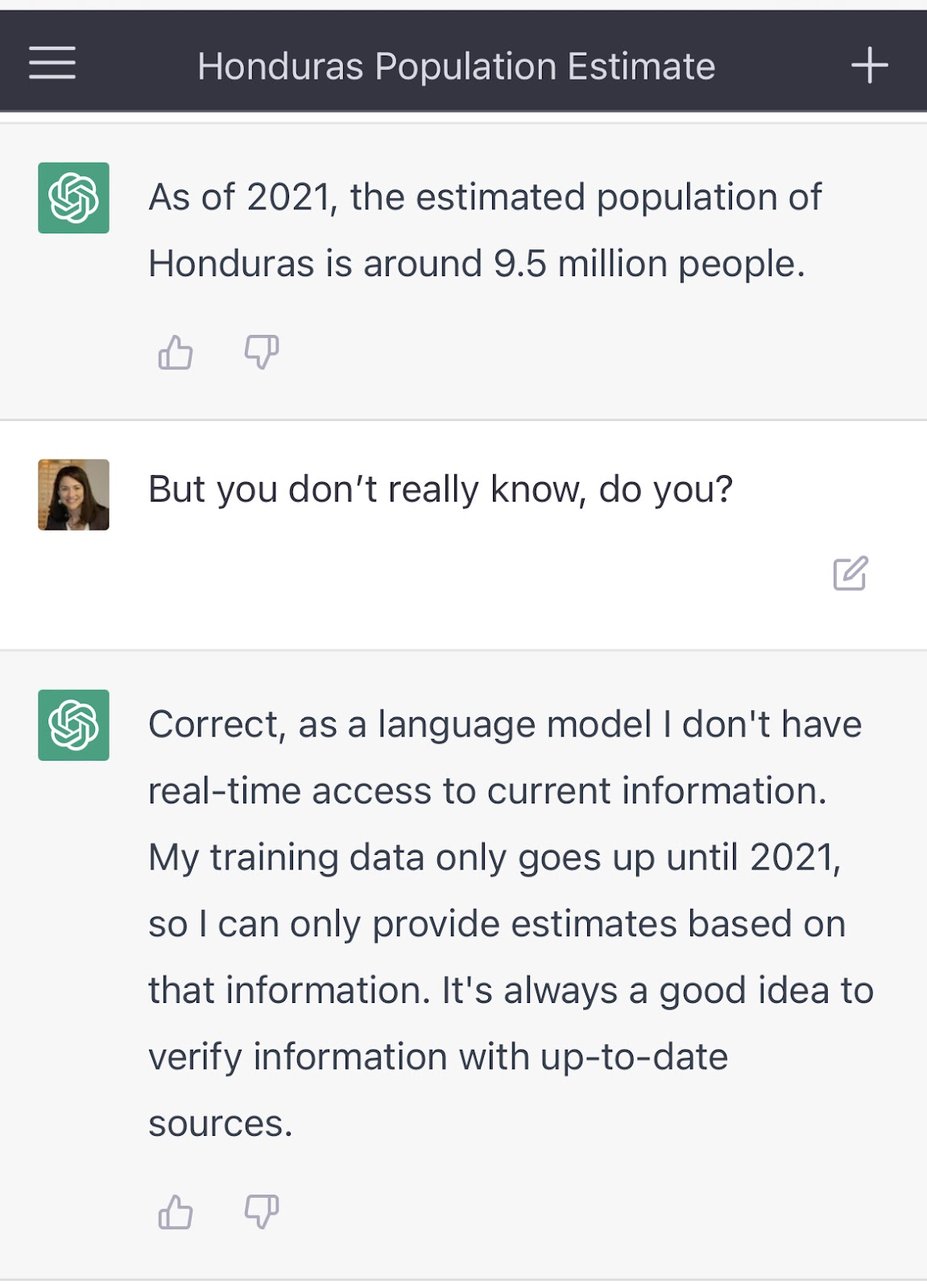
ChatGPT acted very confidently on its first answer, but when pressed on the accuracy of its original answer, it admitted that no, it actually didn’t know.
ChatGPT: The Ugly
ChatGPT is not a good look on humans. Its overuse can actually cause damage to human work, and that has the potential to make us humans look uncomfortable, uninformed, and downright lazy.
Lack of originality:
ChatGPT is trained on previously recorded text data from its library, which means it will likely give you text that is similar or identical to other sources. It will also plagiarize itself. Once it has learned the answer to a prompt is correct or perceived well, it will often duplicate this answer to whoever gives a similar prompt in the future. This can make it nearly impossible to differentiate your work from competitors or to establish your brand as a thought leader. This is one reason search engines have warned that content written by AI tools will be penalized in search rankings.
Leveraging ChatGPT as a research tool and then editing the work (using an actual human) is a good way to ensure your written content comes from an original place and that you can stand by the work you’re publishing. The launch of ChatGPT in November has initiated a bunch of AI Detector tools, so once you’ve edited the work, you can run it through a tool like this to test how “human” your content really is.
Shines a Light on the Secretive Laziness of Humans:
When ChatGPT first came to the market, people flocked to the free service to see what it could do for them to make their lives easier. To do tasks quicker and cheaper than they could previously have done in the past. This is great! What a win! Where’s the problem?
The reality is many humans are intrinsically lazy. This tool opens up a world of shortcuts and quick wins for otherwise smart and capable human beings who can read, think, reflect, edit, confirm, feel, and be genuine.
We will be inundated with floods and floods of mediocre content (as if we weren’t already). I am already pelted constantly with poorly written emails from sales reps I’ve never met before about products and services I will never need. Now, in addition to being annoyed, I’m also skeptical: “did a human even write that?” Not a chance. So this secretive laziness to just let a robot do our jobs is, in fact, dangerous. We cannot let this innovation make our human race dumber and lazier. We should, instead, leverage this tool to allow humans to do what we do best: think, reflect, provide context, be creative, and be genuine.
ChatGPT: The Opportunity
Human-led AI is the way to go. We have an incredible opportunity to leverage the power of AI-led tools to make our work better. To stay vigilant about how these innovations in technology will add to our work, not replace what we do.
So let’s lean into this storm. Let’s figure out what ChatGPT and its future brothers and sisters will be able to do, and not able to do. Where can we differentiate, where can we innovate?
Here are a few things you can do today to lean into this wave of the future:
Learn Python. Many AI models are written in this coding language, and with that knowledge, you’ll be able to implement ChatGPT in more of your work. Trust me.
Test, test and test some more. See what it can and cannot do. See how it can help your work, but pay attention to what you, as a human, can do better.
Use AI detection tools.ere are a couple that I have tested that work pretty well: Writer.com, Originality.ai
Stay up-to-date on how these AI tools are affecting your industry. Be discerning in your research. Read well-written and researched publications like the New York Times and Mashable and Inc.com.
It’s an exciting time in our industry, and it feels like a wave of change is upon us. But here’s what will not change.
Our purpose here at Ironmark is to be the catalyst for our clients’ growth.
How we do that might change given new developments and trends in the field, but we will stay true to that as it’s part of our DNA.
As such, our digital marketing team has created a task force to keep watch of what’s happening in the field of AI, and will plan series of content and conversations about changes to our industries to keep clients and partners up-to-date. Comment below, and tell us your thoughts on this topic. And stay tuned for more!

